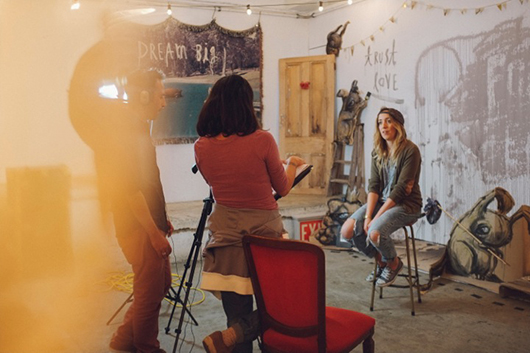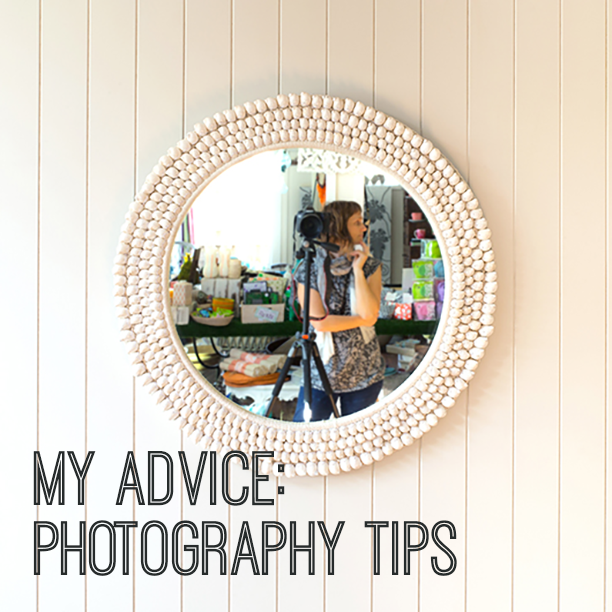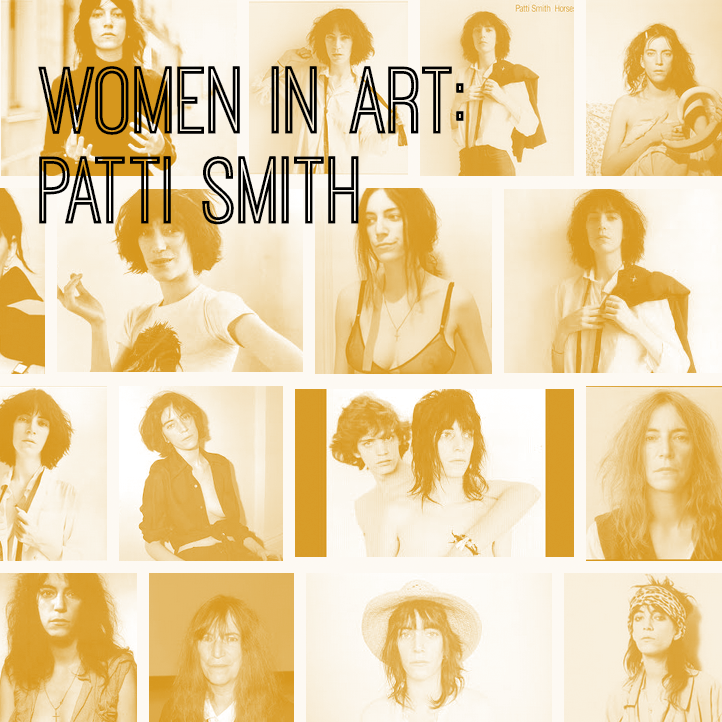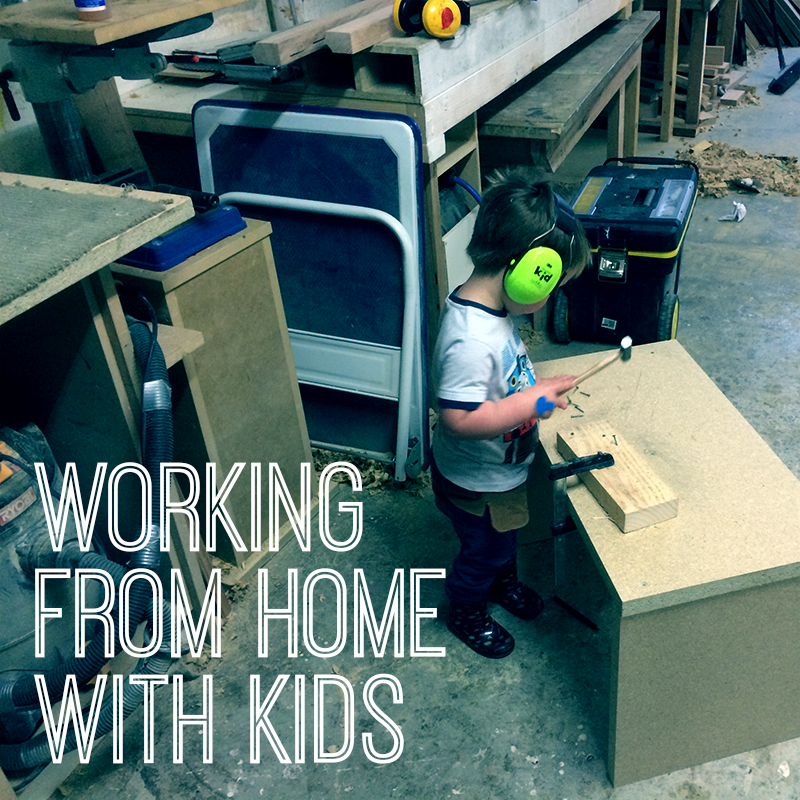Studio visit: Hayley Welsh, Street Artist
By Kristen Marano
Perth Street Artist Hayley Welsh works out of her home garage, but there’s nothing garage-like about it. Welsh has created a space that reflects every bit of who she is: a street artist, traveller, and family person.
Travel trinkets—mostly American flags from her school bus project —adorn shelves; colourful patterned rugs keep out the cold, and a refinished wood grain table lines the back of the room. Welsh has neatly organized a corner of paintbrushes and paints; vintage picture frames lay stacked on the floor, and the main garage wall is covered by floor to ceiling canvas and butcher paper for Welsh to sketch and paint on.
I met Welsh at her exhibition Hijacked, a collaboration with her partner and Photographer Andy Faraday. We recently caught up on a Friday afternoon to chat about her creative process, and how travel has influenced her work…
Describe the process of developing Hijacked and your choice of materials.
The whole thing was about seizing control of the situations that come to you and try to make the best out of things. It’s a belief that both Andy and I mirror in our work: try to seize what’s happening in your life.
I guess I looked at things I had been collecting, the ones that spoke to me that I could use to portray this ‘hijacked’ message. I had a collection of articles I was going to work on; Andy had been shooting his work in film and developing it. So, before the show we sat down, and I looked at works that Andy felt like that he would be happy for me to work on. I talked about pieces that I could see something happening. We wanted to create a show that we’d like to go see: sculpture, installation, a mixture of stuff and experiences. We tried not to make it a clinical and typical gallery space and more of an experience.
Describe the moment when you knew you wanted to create an exhibition about fear.
I was kind of dissecting what I was already creating. Figuring out what was I making, and what these creatures were. I realized it was all this recurring self-doubt.
When I held, Not You Again, which was a show about dealing with self-doubt, I read a book called, There’s Nothing Wrong With You. It was about how self-doubt and fear spreads to you from an early age. I thought it was interesting, and it explained a lot about why I feel the way I do. After reading that book I felt inspired that I wanted to explore that feeling.
How do you use this space to create?
I’ve been painting portraits a lot, and using this mirror to draw my reflection. My mood changes a lot in this space, and this wall can dictate the mood I’ve been in.
I don’t come into the studio until I’m ready to paint; I never enter the studio before lunch. It’s always messy before a show. Everything is pushed to the side, and everything I want to shoot is on the floor. “I’m always jumping from my computer to paint,” Welsh says with a laugh.
How has travel influenced your work?
Travelling is such a massive part of feeling empowered and meeting new people. I find you just get richer and richer in your experiences; you broaden your mind so much more. I can’t imagine my life without having travel being a big part of it. Travel has given me the kind of confidence to keep challenging myself, and keep stepping out of the comfort zone. We create better things when we are challenged.
That’s what I found with the school bus project a year ago. We had a show organized in New York, and we didn’t have the work for it. We decided to create the work while we were there. We bought a bus on the west coast, travelled to east coast, and I found whatever objects. I had a lot of self-doubt like what am I doing with my life? Why are we in a bus? But, I loved every second of it. All these emotions created that body of work.
What’s next?
Welsh had told me, “My dream would be a warehouse where I can relax, invoice, do admin stuff.” Maybe her dream is about to be fulfilled. Welsh and Faraday will soon host Not Another Open Studio, an invitation to join the duo in their new studio and see their new work in progress. Visit www.welshandfaraday.com to follow what they're creating.
{Title photograph by Kristen Marano}
Kristen Marano is a writer living in Perth, Australia. Kristen interviews women in business and writes about workplace culture. She contributes to Huffington Post Canada, and produces a weekly newsletter, Creative Women Weekly, featuring stories of creative women from around the world. Follow Kristen on Twitter @kmarano and Instagram @krismarano.
My Advice: Photography Tips
Human beings thrive on the visual, especially those who consider themselves creative. The online world reflects this - today our businesses and creative output is supported by image-heavy blogs, websites, and social media feeds which make it important to represent yourself and your imagery in the best possible way.
This month, I asked three professional photographers for their tips to improve the result when you're tasked with presenting your products or work in the best possible light.
Karina Sharpe, Conceptual Artist and Product Photographer www.karinasharpe.com.au // Instagram // @karina_jean_sharpe
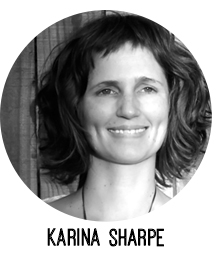
Imagery is big these days, and high calibre imagery has become both the norm and the expectation. I teach a lot of people how to take good photos more effortlessly - and less by accident - in my Benchtop Photography workshops. These are the three tips that people seem to find of most value.
1. The direction of LIGHT, in relation to an object’s position and orientation, can be the single most transformational element of your photographs. This is because objects have a form that will show itself differently depending on how its surfaces are lit up. Begin to notice the light around you and where it is coming from. Try and set your arrangements up on something that you can spin around in relation to the light source. Then, play with how the light falls onto, and across, your objects. Observe what gives the most captivating result.
2. SHADOWS are definitely not your enemy. In most situations we want to engage with our audience on an emotional level, and shadows provide depth, tangibility, realism and substance. However, we want to try and avoid the shadow of one object falling across another object, so become aware and move your objects if shadows are falling in an unfriendly manner. Also, try to avoid double shadows. If you notice this is happening, try to eliminate any extra light sources.
3. Creative use of BACKDROPS allows our images to standout, be recognisable, and build consistency for our brand. Coloured paper or cardboard are easy options, and things like tiles, fabric, flooring offcuts and fake timbers & textures give even more scope. Choose surfaces with your brand’s ethos in mind; timber is not just timber – white-washed might look refined and adventure-y, whereas a dark rough grain would be more earthy and homespun. Ask yourself, which timber am I?
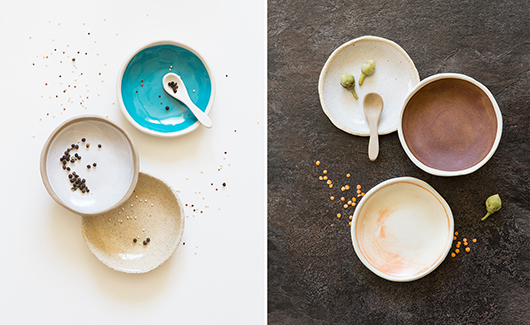
Jessica K Reftel Evans, Photographer www.amorfo.net // Instagram // @amorfophotography
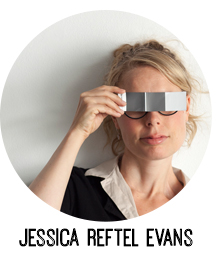
Before setting out on taking your images it's a massive time saver to work out clear visual objectives. Storyboard what it is that you're trying to achieve; a colour palette/mood-board and if you want these images to be more editorial/environmental or clean/factual. Take these thoughts with you as you prepare the shoot with backgrounds and props. Keeping the styling consistent is the key.
To display most products honestly and flatteringly I would suggest using a soft light source. If you don't have special lights you can use a window. Avoid direct sunlight and diffuse the light with a photographic scrim or thin white fabric. If the shadows are too heavy use a white card or another piece of white fabric on the shadow side of your product. Also, turn off your roof lights since they might change the colour temperature and light of your image. The colour of daylight changes throughout the day. So to make sure that your images have consistent and accurate colour representation use white balance settings. This can be done either on your camera or in your image processing software.
And remember, you might not get the perfect image the first time. So just practice, experiment and most importantly have fun. Happy shooting!
Hannah Rose Robinson, photographer www.hannahrose.com.au // Instagram // @hannah_rose_robinson
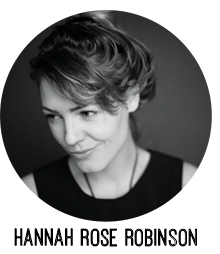
Tell a story. In today's world we are so bombarded with images everywhere we turn that it's hard to stand out. A visual identity is so important - carving out a style that is unique and becomes a recognisable brand, they tell a story through all the elements involved. Photography is just one element of that but an important one. Use imagery that tells a story, or evokes an emotional response. Put multiple images together to create a mood, or piece together a narrative. Write something to accompany the image/s, tell a story. I want to know what people are about, how they feel, their views on the world. Show your process. This is engaging and people like to be invited into the intimate space you can create with images and words. No matter what the subject matter, food, products, people, how can they be a story. What else is in the picture, what else can help tell my narrative.
Be unique. We are all guilty of scrolling Instagram or a favourite blog and getting tunnel vision on someone else's style when we see an image we fall in love with. Try not to get lost in this. I like to see people be different from the masses, find their own vision. There will always be trends that will come and go, but if you spend some time looking deep and hard on what your core vision and personal brand message is, you should be able to start carving out your own style. Be inspired by the images you like, but don't look to be a copy. Look to what the elements are that you like in those images (maybe it's the light or tone or mood) and be inspired by them to create your own unique look.
Switch off. The online world that we are all so intrinsically plugged into these days is immense. It takes up a lot of our time, we devote it our time, and it demands our time. Our technology and online lives are so ingrained in our experiences these days that it frankly makes my head ache. So my big tip is to switch off. Every now and then just switch it all off. Don't take a picture, don't blog, don't scroll. Go do the things you love to blog about and reconnect with them on a fully present scale. It's easy to miss the essence of a moment, lose sight of the essence of your work- whilst being lost in how to capture and share it. Every now and then, switch off and revaluate the process. Go climb a mountain purely to feel the joy in the ache of your legs, to feel the air sweetly fill your lungs, to drink in that view from the top, be fully present. Don't take a picture. Make a memory, and keep it for yourself. Put them in your bank to inspire you. It reboots your brain, and will only mean great things for all your creative endeavours.
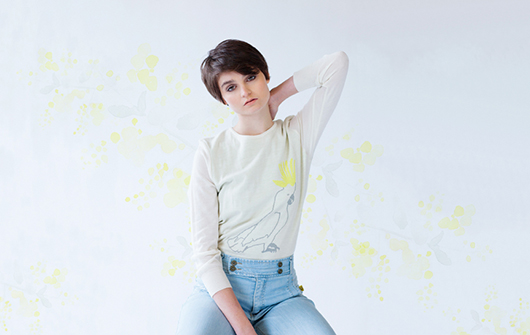

- - - Thank you ladies for sharing your photography tips. I am definitely going to have a play with my camera soon!
{Title image by Karina Sharpe}
Andrea McArthur (www.andyjane.com) has a passion for all things visual and works as an Art Director and Designer for the Brisbane Festival. Design is her true love and she goes weak at the knees over strategic branding. You’ll find her sharing on Instagram @andyjanemc.
How to give an amazing talk: Part 1 - the killer visual presentation
So, you’ve been asked to give a talk to an audience on a topic that you’re somewhat of an expert in (even if the topic is yourself and your career/business!). Congratulations! Speaking publicly may strike fear into the hearts of some, but for those who want to overcome this hesitation or who simply love engaging with a captive audience and sharing your story, I’ve composed this two part series to make your talk even more amazing.
While the ‘talking’ part of the talk is a given (I’ll go into this in more detail next month), what is optional is a visual presentation to highlight key sections, underline points, and generally give the audience something else to engage with. But, you can’t just create a visual preso ‘off the cuff’ - it requires careful preparation and planning, even if your presenting style is more freeform on the day.
What is on your slides, paper, boards, or whatever it is that you are presenting from, can be simple but it needs to be considered. Here are my top tips for designing a killer presentation.
1.Text on screen: Less is more. This is personally my biggest bug bear, but also one that I have been guilty of in the past. When putting the presentation together, it is very tempting to put every single word you want to say as copy on the slides. But often times this distracts your audience from what you are saying, given that they are trying to read and listen at the same time. This practice can even lead you down the path of simply reading your presentation from the screen. Use a text slide to highlight the topic or key phrases, and if you are worried that when you leave your audience won’t remember what you said, consider summarising via a flyer, emailable presentation file, or other takeaway item.
2. Images are your friend. Images and infographics on screen can replace words in many instances. Heard the saying ‘a picture tells a thousand words’? For a killer presentation, it is true. Find relevant imagery that helps communicate your story, and let the image support what you are saying while your audience listens to your words.
Infographics can be a creative way to present information/data in an attractive visual format, and it can make it much easier for the audience to digest information that might otherwise be technical or dull. There are many online applications that will assist you to create infographics. Using these where you can keeps your presentation interesting and visually exciting without losing the integrity of the information.
3. Don’t overlook the basics When putting together a presentation, some basic things can be overlooked, but they may be crucial when the purpose of a presentation is to pitch for a job or represent your brand in its best light.
- Spell check! If the program you are using to compile your presentation doesn’t have a spell check option, simply copy and paste the text into a program that does and fix errors where required. Don’t forget to double check that the company or client’s names (if they appear in the presentation) are spelt correctly. It’s a rookie mistake but often overlooked, and these types of errors are unfortunately more obvious on the big screen!
- Name your sources. If your presentation includes any statistics, quotes, images or content created by a third part, be sure to give due credit or ask permission from the source. Name it, either on the relevant slides or at the end of the document. Don’t claim it if it is not yours.
- Check the presentation file loads correctly on a third-party computer, and have a backup saved somewhere else with you when you go in (e.g. on a USB stick or online). Make time to ensure the equipment at your presentation location is able to handle your presentation file, and test it (with time to make changes, or come up with a plan B if necessary).
- Consider adding slides that ‘Open’ and ‘close’ the presentation, to make sure your audience know when you’re done.
Finding the balance between what goes in the presentation slides and what you say can be difficult, but spending a little time to consider these things can make for a stronger and more successful presentation. Plus, feeling prepared can help to make you feel more confident for when you get up and present.
Stay tuned for my next post in September, where I’ll cover things to consider when you actually get up to speak!
Jes is a ‘practical creative’ and a very busy lady, doing the business in a digital agency, being an artist, a university lecturer, and small business owner who can creatively be found cutting up a storm at paperchap.com. Follow Jes on Instagram and Facebook.
How to design your own creative workspace
I was never much of a desk or office person. In my previous profession as a lawyer, I had the opportunity to work at a communal desk and then was later given my own private office. While I do enjoy working in a quiet environment, attending the same location/room/chair each day was a challenge for me. So it’s no surprise that having now moved out of the corporate world and running my own interior design studio, the opportunity to work where it suits me best, is such a benefit to me.
While I still have my own office, where I get to display, decorate and style my own way, I don’t have to confine myself to this location, every day. Luckily for me, my role as an interior designer means I’m not always designated behind a desk, so I embrace the opportunity to mix things up and find spaces that give me the freedom to work at my greatest capacity and feel creative.
Transitioning from a practising lawyer into an interior designer, I have learnt how how to set up my work environment to maximise my ability to think and dream creativity for my clients. In this two-part series, I will share with you how you can adapt your environment to give yourself the opportunity to maximum your working capacity and allow yourself to be creative. In my following post, I will interview other creative women from Creative Women’s Circle to see what others are doing to inspire their creativity. Hopefully, during this process, you will gather some inspiration to covert your workspace into an inspiring, creative one.
Think beyond the desk
I think we’ve all learnt to believe that you are most productive when you sit at a desk. After all, for many of us, going to work means sitting at your workstation in an office environment, right? Not necessarily. Some of my best work has taken place in my favourite cafe with my headphones on, in the local library on one of their many armchairs with my feet up, or even taking my meeting calls as I walk through a city park or stroll along the beach. After spending the last year in LA and not having a designated workspace, I’ve learnt that I can equally if not more so, be productive at locations that make me happy and accommodate my needs (i.e. internet access). So think beyond the office desk and immerse yourself in various environments to allow yourself to think differently.
Your space is an extension of you
If however, routine, consistency and organisation is what you need to work productively, then a designated workspace may be the winning formula for you. In that case, before you set yourself up and run down to the nearest office supply store for your standard desk and chair combination, reconsider your space. Why not create an environment that makes you feel excited to come to everyday?
A few ways to avoid working from a typical workstation:
- Choose an unconventional desk chair - maybe a favourite armchair or dining chair? Or set up a few different seating arrangements in your space like a bean bag or sofa.
- Bring in your favourite table lamp or floor lamp.
- Choose a dining table for a desk and use boxes, crates, baskets and bedside tables as alternate storage options.
- Create a vignette of little pots in one corner of your desk, filled with greenery to offer you constant energy throughout your working day.
- Avoid bare and blank walls by hanging up your favourite prints or posters to keep you motivated and inspired.
- Place a sheepskin rug at your feet to keep you cosy and warm at the desk.
- Be adventurous with colour and paint a wall in another hue, or for the bigger risk taker, introduce some wallpaper!
Co-work spaces and four-legged friends
Last year, in LA, I spent some time in a co-work space in Santa Monica. Not only was this space a breath of fresh air from the stagnate interiors of the corporate world, it was an opportunity to meet new people, each doing their own thing. A fabulous place to network, discuss and explore your ideas with like minded attitudes and work in an environment that was comfortable, relaxed and free from rules and systems. Plus, most co-work spaces allow you to pick and choose the days you want to come in - so there’s no on-going commitment!
One of my favourite perks from working in this LA co-work space was it allowed guests to bring along their dogs for the day. This was such a delight! I instantly felt more relaxed and comfortable in my unfamiliar surrounding with a furry friend at my feet. Generally, dogs were well behaved, even as they roamed the hallways or nuzzled their noses into your legs, begging for their next scratch.
If you are lucky to have a gorgeous four-legged friend, next time consider taking him on a walk on your next meeting call or to sit beside you when you work from your laptop at your favourite cafe. I found that having a dog near by helped me keep calm and relaxed during my work day and a good excuse to take a break and pop outside for a walk.
Look inside then look around
To maximise your creative energy each day, you need to understand what sort of environment you work best in. Be open to exploring different locations like a home office, co-work space, local library or cafe and if it suits you, don’t restrict yourself to the same space every day. Give yourself the opportunity to explore new surroundings in hope to encourage you to think a little differently. For some of us, who thrive on routine or require a point of reference for work, don’t limit your environment to a mundane, boring space. Avoid conventional furniture arrangements and use unexpected pieces that will help you create something special. Be passionate about where you work! Setting up a workspace that makes you feel comfortable, as well as address your business needs, will no doubt keep you feeling creative and excited about what you do. Choose to create a space and find a location that reflects who you are. After all, how you work and play is a representation of your business and brand. Embrace this to design a space that is an extension of you.
Interior Designer, Diana Scully owns and operates her own interior design firm, Spaces by Diana that’s all about designing beautiful, personalised homes to reflect the people who live in it. Diana also has her own lifestyle blog, Spaces + Places, where she regularly writes about inspiring spaces to see and visit from around the world and shares her recent travel adventures. This year she has plans to spend time abroad in the US. Follow Diana on Facebook,
Accounting tips for your creative business
One of the biggest challenges for creatives can be understanding and keeping up to date with the accounting side of their business. Understanding the numbers in your business is a vital skill that can remove much of the guesswork when you make decisions regarding the profitability of your work. When you have access to real data and can identify concrete trends across the profitability of the products and services that you offer, you can make decisions based on real information, not just a gut feeling.
As a jewellery maker and designer myself, I completely understand that managing the books can be a difficult and tedious task, because before I changed to a creative career, I was working in the accounting industry. So today I want to help you gain a better understanding of your numbers and the areas where you generate the most and the least amount of money, by explaining two must-have 'business report cards' and guiding you through how they can assist you to monitor and assess your business profitability.
1. Profit and Loss Statement
Your Profit and Loss (P&L) statement shows how your business performed during a period of time. There are three main factors of a P&L statement:
Revenue: Any sort of income you earn, whether it be from sales of products or services, commission etc; and
Expenses: Any sort of expense you spend in the course of running your business like:
- Cost of goods sold
- Supplies and materials (raw materials you use to make your products – fabric, beads, glue, metal etc)
- Rent
- Advertising (Facebook ads, Google adwords, marketing materials like business cards, post cards etc),
- Fees and charges (online shop fees, PayPal/credit card transaction fees, bank fees, EFTPOS fees, website hosting fees, stall hire fees, consignment fees)
- Office expenses (stationery, printing)
- Subscriptions (magazines/journals related to the industry your business operates in)
- Postage
- Utilities (electricity, gas, water, telephone, wifi)
- Insurance (home and contents, theft, public and product liability)
- Professional services (legal, accounting)
- Repairs and maintenance (equipment your business uses)
- Wages, superannuation etc.
(Please note this is a example of the kind of revenue and expense items a typical business may have - yours may vary.)
COGS (cost of goods sold): COGS refers to the costs directly associated to the production of a product. This includes any material costs, labour, shipping and other costs to transform the product to be ready for sale. Determining the COGS can be one of the more difficult things to calculate and the value changes depending on which valuation method you use when you’re doing your books. But to explain the concept simply, let’s go through an example. Let’s say, I have $100 worth of beads in inventory at the beginning of the month. I buy an extra $20 worth of beads during the month and have $50 worth of beads at the end of the month. How do I calculate my COGS?
(Beginning inventory: $100) + (Purchases: $20) – (Ending inventory: $50) = Cost of goods sold: $70
For more information or assistance developing your specific COGS, have a chat with your accountant!
Now here are some key formulae for a P&L statement:
- Revenue – Cost of Goods Sold (COGS) = Gross profit
- COGS = opening stock + purchase – closing stock
- Gross profit – expenses = Net profit/net loss
Remember to keep receipts for EVERYTHING you purchase, whether it be offline and online. For online purchases I like to save each receipt into a specific folder on my computer (and I also back it up regularly). You might prefer to print out your receipts and keep them organised in folders dedicated to a single month or specific financial year.
2. Balance Sheet
Your business' balance sheet shows your assets, liabilities and owners equity as at a specific date.
Assets: Cash, accounts receivables (money you have invoiced your clients that you have not yet received), inventory, investments, tools and equipment and any other asset your business owns
Liabilities: Money that your business owes (you have been invoiced for a service you used and have not yet paid or materials you have bought but not yet paid for), accounts payable, bank/credit overdraft and any other debt
Owners Equity: Anything that is left over, once liabilities have been paid for from assets. If your equity is high, it means that your assets outweigh your liabilities, if your equity is negative, you’re losing money, and your business isn’t making enough money to carry the level of debt it’s carrying.
The basic accounting equation for a balance sheet is: Assets = Liabilities + Owner’s Equity
Ageing receivables and payables.
If you sell products or services, you’ll need to keep a track of the ageing of receivables and payables. Ageing is usually broken up into four categories: 0 – 30 days, 31 – 60 days, 61 – 90 days and 91+ days.
When you issue an invoice to a client or customer, the longer the invoice goes unpaid, the higher the likelihood that you may not get paid at all. It’s important to monitor invoice payments, so you can chase up a client if the invoice becomes overdue. A debt is said to 'go bad' when the client doesn’t pay or can’t pay, which may mean you need to write it off as a bad debt. Not getting paid is certainly not good for your business!
Other useful accounting tips
Set up a dedicated bank account
It’s a good idea to set up a dedicated bank account for your business. Therefore, whenever you update your financial information, you don’t need to wade through all the transactions to pick out the ones that are personal and which ones are business-related transactions.
Let technology help your keep track of your data
There are lots of techonology options to help you manage the data your business sales generate, so you can turn it into information that’s accurate, relevant and timely for decision-making. If you’re just starting out or your revenue and expenses are quite straight forward, you could use something as simple as an Excel document to keep track of everything. Otherwise, cloud-based accounting software such as MYOB, Xero or Waveapps offer a host of benefits - though some might incur a monthly fee (but most have a free trial period so you can see if the investment works for your business needs).
Make accounting part of your weekly or monthly routine
Depending on the level of activity your business generates, you should update your financial information weekly or at least monthly to give you a good indication as to how your business is performing. Choose a day or even half a day each week/month, and dedicate yourself completely to managing and reviewing your P&L and balance sheets. Remember, this day is important to spend on your business and not in your business.
Do your own books (or at least keep a close eye on them!)
When you’re just starting out, I totally recommend you do your own bookkeeping so you can understand what is happening in your business, rather than outsourcing it straight away to a professional bookkeeper or accountant. As your business grows, and your business generates more activity, it may be worthwhile bringing on a professional to assist, so you can concentrate on the things you do best and provide most value to your business. Bu having said that, even when you have outsourced these tasks to other people, it’s still important that you understand the accounting and continue to review the numbers from month to month.
Get started today
If what you've read sounds great, but still a little overwhelming - never fear. Over at my website I’ve created a customisable P&L template for you – so you can use this immediately for your business! The template contains instructions to guide you. Try it out and I'm sure you'll get addicted to how knowing how your business is going financially. Happy accounting everyone!
NOTE: This article is intended as an EDUCATIONAL GUIDE ONLY and is NOT INTENDED to be taken as specific financial advice. Please discuss your business' financial performance with a qualified accountant, solicitor or financial advisor.
Monica Ng left her accounting career at the end of 2013 to run Geometric Skies, her Etsy jewellery business, alongside her jewellery and object design studies at the Design Centre in Sydney. Find Monica at her blog or on Instagram @geometric_skies.
Women in art: Patti Smith
By Jasmine Mansbridge
Patti Smith is a writer, performer and visual artist, often affectionately referred to as the “grandmother of punk”. She was born in Chicago on December 30, 1946 and is still touring and creating today. She grew up in rural New Jersey, moving to New York in the 1970’s. It was during these years, living with fellow artist and friend Robert Mapplethorpe, that she soaked up the atmosphere of the 1970’s experimenting with various art forms, including writing poetry and creating artwork.
My quest for information about Patti went as it usually does, “watching” YouTube clips while I painted, listening to interviews and reading whatever information might be available. I also read Patti’s memoir Just Kids, which she wrote in 2010. The book documents not only her own journey as a young emerging artist, but also her complex relationship with fellow creative Robert Mapplethorpe. Patti Smith’s written work is a pleasure to read. She has a natural way with words. She draws you in to her inner world and connects with readers on many levels.
On being in a relationship
Patti speaks openly about the key relationships in her life. Reading books Patti says, shaped her ideals about being female, romance, relationships and freedom. She was given “The Fabulous Life of Diego Rivera” for her sixteenth birthday and in Just Kids she says, “I imagined myself as Frida to Diego, both muse and maker. I dreamed of meeting an artist to love and support and work with side by side.” These words indicated to me Patti’s romanticised ideal of a relationship.
Patti and Robert Mapplethorpe’s story is an intriguing one. They met not long after she arrived in New York and their relationship became one that was pretty much based on Patti’s muse/maker ideal. Their common bond as artists meant that they were able to maintain a bond and a deep friendship throughout their lives, even after their physical relationship changed.
In the early days, Patti worked various day jobs to support Robert while he worked on his art full time. She saw this as her contribution to his career, it wasn’t until later on that she was able to work of her own material full time.
The passing of time saw Patti and Robert’s relationship change, as Robert came to terms with his homosexuality. They continued to live together and support each other, however, agreeing to do so until such point at which they had both become independent of each other.
A high point in Patti and Robert’s relationship was the exhibition they had together at the Robert Miller Gallery in 1978. This was to be Patti’s first exhibition in the Gallery and the only time the two exhibited together. After this exhibition, they both went their separate ways, having kept their promise to see each other safely to success. Patti went on the road with her band and Robert’s focus became more and more on his photography, which was bringing him high acclaim.
Patti’s next significant relationship was with Fred Sonic Smith. Fred and her were both musicians and they met when she was touring. They bonded over a common love of poetry and Patti says it was Fred who she decided to marry in 1980, (the joke was apparently that she married Fred because she wouldn’t have to change her surname).
Patti talks warmly of her relationship with Fred and their move to the suburbs of Detroit. She said this time had been similar in feeling, to her early days with Robert Mapplethorpe. Starting with nothing but a few favourite things for possessions, and then waiting to see what the future would bring. Patti and Fred went on to have two children, Jackson and Jessie, and settled into a routine dictated by their domestic needs.
The next space in time was one of deep sadness for Patti. These two important men in her life both passed away. Robert died first of HIV AIDS in 1989 and then her husband Fred of heart failure in 1994. In this same period, Patti’s brother and her pianist also died. At this point Patti decided to take a break from her creative career to focus on bringing up her two children, moving from Detroit back to New York.
It is truly moving to hear Patti’s first hand accounts of these significant relationships as she shares them in her memoir. It is Patti’s openness and vulnerability that further endears her to her fans. One gathers that in her life Patti loves deeply, loyally and unreservedly. My observations are that Patti has always been an equal partner in her relationships. She talks about relationships in ways that take responsibility for her own actions in them, right or wrong.
I took away from this the importance of honesty and complete acceptance of another person. To allow each other freedom and space, for both difference and growth. Of course this is always easier said than done. But, as in Patti’s case, the rewards are reaped in having that understanding and room to move, granted to one’s self as well.
On being creative
Patti says that as a child she was not gifted, but she was imaginative and that she was rewarded at school for being so. She says of being an artist that, “I had no proof that I had the stuff to be an artist, though I hungered to be one.” From childhood Patti had devoured books and poetry and she talks about having the sense that there was something for her to say as an artist, and that somehow she would find her voice.
Patti has ended up a household name for being one of the first “poet” musicians. She was basically a published poet who went on to add rock/punk musical layers to her words. She landed a record deal and released the debut album “Horses” in 1975. Her work subsequently had a major impact on both the punk movement and the associated musical scene, especially in America and England. Patti became an icon to subsequent generations of punk rockers. Patti is also a visual artist and has been represented by the Robert Miller Gallery since 1978.
What struck me ,the more I researched Patti, is the calm she seems to have maintained about being an “artist”. Even when she felt like she had nothing to show for the fact. She never seems to have appeared anxious or desperate about having her work seen or heard. It seems like her sense of self was always there, unwavering. She credits her association with Robert Mapplethorpe for this attitude.
In her dress and her manner she never appears to be overly concerned with material things. It is her books and her tools such as pencils and notebooks that she treasures most. These things all speak to me of a deep inner self confidence.
During the early years of her career Patti seems to have met the right people at the right time. People who encouraged her and gave her opportunities. Patti says in her memoir that at times her success had seemed to come a bit too easily, and that she hadn't wanted that. Patti actually turned down the first opportunity to publish her poems because she felt she had not earned the right and “the spoils of battle were not yet to be hers”.
Of all the knowledge I gleaned from Just Kids, there is one quote that will remain for me: “That we are mortal, our work is not, do your best work, let your work stand alone”. This is wonderful advice for any artist at any stage in one’s career.
Patti has gone on to have a lifetime of achievement. In 2005, Patti Smith was named a Commander of the Ordre des Arts et des Lettres by the French Ministry of Culture and in 2007 she was inducted into the Rock and Roll Hall of Fame, both fitting honours for this artist who has lived true to her ideals of creating original work throughout her lifetime.
On being a woman
It is hard to not make a comment about Patti’s appearance. It is one of the things about her that has impressed me. With her strong nose and thin frame, Patti has an androgynous, raw beauty which adds to the uniqueness of her character. Throughout her life she appears to not give a damn about what others think. The original “messy hair, don’t care” girl. I see much of a current “it” girl, Alexa Chung mirrored in her look. Rail thin with bangs and over sized t-shirts (I wonder what Patti thinks of that?).
Patti often describes herself as having been an outsider and a wallflower in her youth. As a young girl she found the changes in her body as she grew, awkward and unwanted. She says she wished she could have stayed a child forever, just like Peter Pan.
In her role as artist Patti has never made an issue of her gender. She talks about this as being a deliberate act on her behalf, so she could be a kind of “third” gender. She sought to call attention to herself as an artist, not as a woman. Patti simply dressed and performed in the spirit of her male rock and role models, as if no alternative had ever occurred to her. In the process, she obliterated the expectations of what was possible for women in rock, and stretched the boundaries of how artists of any gender could express themselves. Patti saw her music as a way to be genderless and many of the lyrics of her songs are ambiguous with regards to meaning and sexual references.
Another fact about Patti that I found interesting is that she was not a drug user. And I am not alone in presuming that with her waif like appearance and with the culture of drug use in her time, that she would of been “on” something. Her peers back in the day also presumed she was a drug user. Patti didn’t even smoke, although she modelled for photos with a cigarette to perfect a “look”. Patti had the occasional high, but had always felt that drug use wasn’t for her. Patti is the perfect example of why stereotyping people is unfair (and perhaps her choice to not use drugs is a contributing factor in her success even today). Patti was a women who blazed a trail for many other artists to follow.
On being a mother
Patti says that she had felt it a cruel betrayal of nature when after a brief experience with another boy as inexperienced as herself, she found herself pregnant at age nineteen. She speaks beautifully and poignantly of this time in her memoir. She went on to have the baby, adopting it to a couple who could not have a child of their own.
When she became a parent again later in life, Patti took the role seriously, leaving the professional music scene to take care of her children. I admire her decision to do this and once again it speaks of her confidence in herself and in her abilities as an artist.
Patti says that it had been perfect timing for her and Fred to marry and for them to become parents. She had started to feel like she had accomplished her mission with her music and that there was no more room for growth just being on the road.
Later on, after her husband Fred’s death, Patti was left a sole parent to her children. Patti says that her years spent mostly at home being domestic were not wasted and had made her a better human being. Upon reflection she states that being a mother had made her more empathetic and more knowledgeable about the world. That the discipline of caring, cooking, cleaning and washing etc had been good for her. It was also in this period that she began to focus on her writing. Piecing together the story that was to become her memoir.
There is a beautiful quote from “Just Kids”, when Patti talks about being pregnant with her daughter Jessie and visiting Robert for the last time before he passed away. He was gravely ill and she had travelled from Detroit with Fred to New York to spend time with him. Patti recalls, “Within that moment was trust, compassion, and our mutual sense of irony. He was carrying death within him and I was carrying life. We were both aware of that, I know.”
Patti remains close to her children, they are both musicians and she performs with them on stage when she has the opportunity. She says that through them she feels the presence of their father Fred and that they have been a wonderful gift to her life.
Things to learn from Patti Smith...
When you see Patti performing her music in all her rock and roll glory, you only see one side of her. Dig deeper and her writing and speaking reveals a very different side. Patti talks about this contradiction and says it is true, she is as comfortable screaming down a microphone as she is cooking dinner for her children, or curled up reading a book. She is the same person doing all these things. I found this interesting as it is something I wrestle with sometimes myself, the contradictions within ones self. These contradictions Patti says give her the platform to create meaningful work.
I could go on, but in short, here are the most useful things from I gleaned from Patti’s story:
- Remember to keep focused on doing your best work as an artist (not always the most popular work).
- Try not to get caught up in being competitive with other creatives and be creative in whatever way comes to you.
- Avoid wanting the “celebrity” of art, without the work and the sacrifice.
- Remember that it may take a lifetime to work out what it is you want to say, and that what you want to say might change.
- Be prepared for hard times as well as good times.
- Be independent as a women, but also being able to love and be loved.
- Don't let being a women affect your work or how you allow yourself to be perceived.
- It is okay to put your family first when needed.
- You can step back from your creative career and still be successful long term.
- Be your own wise counsel.
- You are mortal, your work is not, so make your work your best.
For more about Patti Smith, check out this video, and this one, and this one; this article at The Guardian; some info about Fred Sonic Smith; and of course, her memoir, Just Kids.
————-
Jasmine Mansbridge is a painter and mum to five kids. She regularly blogs about the intersection of creative work and family life at www.jasminemansbridge.com, and you can also find her on Instagram @jasminemansbridge.
How to work from home with kids
The ‘juggle’ of working motherhood has become a bit of a cliché, but when your days involve filling sippy cups while simultaneously emailing clients on your phone and trying to stop a baby chewing through your laptop cord, it certainly does feel like a circus.
As I've mentioned in previous posts, my husband and I run a handmade furniture business together, so we use a combination of grandparents, crèche and flexible work hours to care for our two young sons. This works well for us at the moment, but the wheels often fall off and I regularly find myself needing to work from home while the kids are around. It can be a challenge – there’s been plenty of of nappy changes on meeting room floors and client calls while playing Lego, but I’ve managed to come up with a mish-mash of solutions that work for our family, and may work for yours too!
Get a routine By routine, I don’t mean a steadfast, inflexible schedule. Just having a regular order to your day makes things much easier for you and your kids. Having a routine helps kids feel secure, and helps you feel like the chaos is at least somewhat under control. I usually try and get any errands or kid’s activities done in the morning so I know we can be home for my youngest son’s afternoon nap. Speaking of naptime…
Naps are sacred There is no one as productive as a parent who is working during a kid’s naptime. Having a time limit on your work can make you super-efficient and forces you to concentrate. I sometimes manage to complete as much work in the two hours that my son is napping as I could in a whole day of being in the studio. You can save up any phone calls, designing or work that requires your full attention for those magic hours. Grab a cup of tea, scribble out a list, then power through it. Try to avoid any distractions (ahem, Instagram) and hammer out as much work as you can in that time.
Embrace technology This is obviously a personal decision, but popping Play School on the iPad keeps my older toddler occupied while my younger one sleeps... and I can get some work done. Watching TV or playing with an app can also save the day if you need to take your kids to a meeting, or make an important call that you can’t be interrupted for.
However, technology can be a double-edged sword. Being able to get your emails on your phone at the playground or order materials online while pushing a pram is a lifesaver for many working parents. On the flipside, it can be hard to constantly switch from building a block tower to emailing a client, and you can end up feeling like you are not really present either with work or with your kids. Setting limits is a good idea, for your own sanity and for your kids. I try not to use my phone in front of my little guys unless it’s really necessary.
Recruit apprentices Depending on what kind of work you do, you can let your kids ‘help’ you work. This is particularly great for any kind of hands-on creative work. My older son has a mini workbench set up at our furniture workshop and can happily spend hours hammering away. If you are working on a computer, give your kids some pens and paper so they can ‘work’ too. Office supplies make awesome toys! A stack of Post It notes, a highlighter and a holepunch can easily entertain a toddler for enough time for you to get some work done.
Be creative Sometimes, no matter how organised you are or how independent your kids are, you have a deadline and you really just need to work. This is when you can get creative and call in back up. Ask a friend to hang out with your kids for a couple of hours so you are free to work (and return the favour!). Take your kids to the playground and explain that you are going to make phone calls while they play. Work from the library or a café on the weekend while your partner takes over kid duties. A photographer friend of mine takes her kids to an indoor playcentre with free wifi so she can edit while they run around for a few hours. Like everything to do with parenting, no one solution will work every time, so it’s a good idea to have a few back up options.
Relax No matter what you think of Disney’s Frozen, sometime you do just have to “Let it go, let it goooooooo!” Your house will probably be messier than usual, you might not get as much done as you planned, and your kids (and you!) might still be in pyjamas at 3pm. That’s okay. Nobody is a perfect parent, and nobody is a perfect creative business owner. Working from home with kids is hard work, so embrace the chaos and remember, tomorrow is a new day.
Emma Clark is an interior designer, writer and podcaster who, alongside her husband Lee, runsGratton Design, a timber furniture and architectural joinery company. She blogs at Worst House Best Street and posts endless photos of her sons on Instagram at @emmamakesthings.


